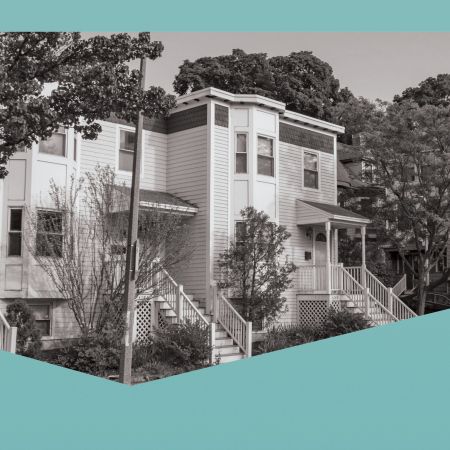How Big is the Racial Homeownership Gap? Depends How You Slice the Data.

By Peter Ciurczak
October 26, 2023
There’s been growing attention to the size of the racial homeownership gap in Greater Boston. While we often use simple headline calculations of homeownership rates by race, researchers like us must make some judgment calls when presenting the data. And depending on these choices, homeownership rates shift somewhat. No matter how you slice the data, troubling gaps remain, but the size of gaps ends up varying by specific groups. So, in this research brief we’ll walk through a few different approaches that we’ve used in the past and explain what each contributes to our understanding of racial wealth equity.
The most common way to derive homeownership rates for a given racial or ethnic group is to divide the number of owner-occupied households by all households headed by someone from that group. Under this approach, we see that two-thirds of White households in Greater Boston own homes —about 30 percentage points greater than Black households, and 35 percentage points greater than Latino households (who have ownership rates of 36 and 31 percent respectively). The Asian homeownership rate falls in between, at 57 percent. Our White/Black and White/Latino homeownership gaps are among the largest in the country.
It’s worth pointing out that this data analyzes only the race of the “household head,” which refers to the individual adult in the household who responds to the Census Bureau’s American Community Survey (ACS). If this person was a Black woman married to a White man, for instance, their household would count toward the “Black” homeowner rate, rather than be included in the “Black” and “White” homeownership rate. In reality, many married couples jointly own large assets like homes, but ownership analysis can get complex if we do not limit it to one household head. Consequently, it has become standard practice to look only at the race or ethnicity of the respondent.
Despite the simplicity of the common approach shown above, it may not be best to look at all homeowners divided by all households. Older adults are far more likely to own homes, for instance, as younger adults are just beginning their careers, paying down student debt, and only starting to save for longer-term investments like owning a home. And because the age distribution varies across racial groups, not accounting for age when looking at homeownership rates can skew the data somewhat. So, in the next graph we recalculate homeownership rates, but for specific age cohorts.
Older people have had more years to amass the funds needed to settle down. Perhaps they also start a household with a significant other, get married and merge their finances. As a result of this extended time and pooled resources, real differences in homeownership rates begin to surface after 25. One of these differences is the startling gap between White/Asian and Black/Latino homeownership rates. Through middle age, White and Asian homeownership rates look relatively similar, with Asian homeownership rates leading or lagging White rates by a few percentage points. Both groups have much higher homeownership rates than Black and Latino households—which are similarly low over the same timeframe.
These patterns change, however, when looking at the two oldest age cohorts. For adults ages 65 to 74, Asian homeownership lags White homeownership by 17 percentage points, falling somewhere between Black/Latino rates and the White rate. And then for the oldest 75+ cohort, Asian homeownership rates are far more similar to Black and Latino rates, with a large gap between these three racial groups and White households. Indeed, just over 70 percent of White households own homes in this cohort, the likely beneficiaries of early homeownership programs and wealth building opportunities that in different ways excluded families of color.
Another way we’ve looked at homeownership rates is by loosely controlling for income, helping us see to what extent racial income disparities might explain why our region has large racial homeownership gaps. Comparing homeownership rates within similar income bands, as we do here, shows that while gaps close somewhat for some income bands, large racial gaps mostly persist across the board.
Differences do close a bit toward the top end of the income distribution, although certainly not fully. There, White households over 120 percent of area median income (AMI) have a homeownership rate 14 percentage points greater than Black households, and 19 percentage points greater than Latino households. The gap between Asian and White homeownership tightens up slightly as well at high income levels.
At the lowest end of the income distribution, however, the homeownership gap is roughly equivalent to when we are not controlling for income at all. About 43 percent of White households own their own homes in the “Up to 50% of AMI” bucket, as compared to 28 percent of Asian households and just 14 and 12 percent of Black and Latino households, respectively. Homeownership rates at the lowest end of the income distribution are lower than homeownership rates overall, and significantly so for households of color.
Still, arranging these groups by income as we do here captures many younger households—often students—who may not yet have had access to the same resource-building opportunities as their older peers. Households of color may also be overrepresented among younger, lower-earning households, as the White population generally skews older. The inclusion of these younger households in our denominator here and in previous cuts ultimately brings down ownership rates overall. If instead we consider the homeownership rate of a group to be homeowners divided by all homeowners and potential homeowners, then it makes sense to control not just for age or income, but age and income.
So, finally, let’s combine these data cuts, and leave out younger households who have not yet reached an age where homebuying makes sense. The graph below is like the one above, but looks only at households headed by individuals 35 years of age and older.
Interestingly, the smaller gap between Black and Latino homeownership rates very nearly vanishes under this approach, unlike when we control for either age or income alone. The White/Asian homeownership gap remains relatively small for all but the lower two income buckets. And both are consistently higher than ownership rates among Black and Latino households.
Focusing in on the low-income bracket, nearly half of White households at this level own their own homes—a remarkably high share. This may speak to the generational wealth of White families, such that even if they themselves make less money, their parents or grandparents may have purchased and paid off the homes in which they now live. This bracket may also be capturing a large number of retirees—and remember the White population skews older—who live off smaller incomes but who have long since paid off their homes and are choosing to age in place.
What we can conclude from these—and so many other—data points is that the racial homeownership gap remains a pernicious fact of life here in Greater Boston. Yet as we slice the data in different ways, and work to account for different demographic realities, these gaps shift: tightening up at the higher end of the income distribution and widening at the lower end. When we talk about homeownership rates then, deciding how to cut the data can help us better understand who we are, or should be, talking about. And while addressing homeownership disparities is complicated, it is doable. Indeed, Massachusetts has more than a few programs available to help lower-income households purchase homes, while the paucity of available housing across the state has brought renewed political and legislative attention to the challenges facing the market.




